Abstract
The ecosystems of the Yarlung Tsangpo River Basin (YTRB) are fragile and sensitive to climate change, so an in-depth analysis of the relationship between the vegetation dynamics in the YTRB and climate change is crucial to understand regional and global climate change. This study quantified the spatial and temporal characteristics of the vegetation cover and meteorological elements in the YTRB over the past four decades. The evapotranspiration data were corrected by combining the characteristics of the vegetation in the region in order to systematically explore the relationship between the vegetation change and climate change response in the YTRB. The results indicated that the fractional vegetation cover (FVC), air temperature (ATEM) and precipitation (PRE) showed a significant increase during 1981–2020, with a variable speed of 0.05/10a, 0.38 °C/10a, and 13.3 mm/10a. The actual evapotranspiration (AET) decreased significantly (32.8 mm/10a). There were positive effects of the increased ATEM and decreased AET on the increase in FVC, with ATEM as the leading factor of influence. After excluding the influence of other factors, the degree of influence of PRE on FVC increased to 2.5 times of the original, and the AET increased by 28.57%. The three climate factors synergistically contribute to the positive development of FVC in 47.43% of the upper and middle sections of the YTRB.
1. Introduction
Vegetation is an important component of terrestrial ecosystems and plays a vital role in the carbon and water cycles of ecosystem [1,2,3]. The healthy development of vegetation contributes to the maintenance of biodiversity and ecosystem stability [4,5]. Since vegetation is extremely sensitive to environmental changes, the dynamic change in vegetation is often considered as a key indicator of global climate change [6,7,8]. Vegetation indices are often used to characterize vegetation growth status in related studies [9,10]. Fractional vegetation cover (referred to as FVC) is derived from the normalized difference vegetation index (referred to as NDVI), which is an important parameter in the studies on vegetation response to climate change [11,12]. FVC measures vegetation health through greening. Although influenced by soil background and atmospheric conditions, FVC provides accurate measurements of vegetation density and spatial distribution [13]. Thus, it has been widely used in relevant research [13,14,15]. In the recent decades, global climate change has led to a series of extreme meteorological events, such as droughts, heat waves, floods, and cold temperatures, which have had significant impacts on vegetation growth [16,17,18,19]. Such impacts alter the energy exchange between the land and the atmosphere, effectively mitigating climate change to a certain extent [20,21].
The Yarlung Tsangpo River Basin (referred to as YTRB) is located in the hinterland of the Tibetan Plateau, which is an area sensitive to global climate change, and which has an overshooting trend to it [22]. The altitude of the watershed is extremely high. The distribution of the vegetation is vertically zoned and the spatial heterogeneity is prominent [23]. The vegetation and ecological environment of the YTRB is very fragile, and it is also an important geographic barrier in China [24]. Therefore, the study of the YTRB vegetation change and its response to climate change has become one of the hot topics [25,26]. Some scholars have analyzed the correlation between the vegetation index and precipitation (referred to as PRE) or air temperature (referred to as ATEM) of the YTRB in the last decade; they have found that the response of vegetation to ATEM and PRE depends on the degree of the influence of meteorological factors on the vegetation type [27,28,29]. Lv et al. showed that there was a significant positive correlation between NDVI and PRE in the YTRB [30]. However, Han et al. found that vegetation growth was overall more affected by ATEM than PRE in the YTRB, and that the vegetation cover was overall weakly sustainable [31]. In a similar study, it was found that an increase in ATEM promoted an increase in vegetation in the YTRB during 1999–2013, but that a limited PRE would limit the growth of the vegetation in the study area [32]. In recent years, it has been found that the NDVI was more sensitive to ATEM, increasing by 1.6–4.68% when the ATEM increased by 1.5 °C [33]. In addition, due to the spatial heterogeneity of vegetation types and climatic conditions, the effects of PRE and ATEM on vegetation vary in the upper, middle, and lower reaches of the YTRB [34].
There are two main reasons for the differences in the results of the many studies. (1) The YTRB belongs to a data-deficient region, with fewer meteorological observation stations. Either the time series of the research data was short, or the continuity of the long-series data was poor, and it was generally difficult to adequately reflect the dynamic change characteristics of vegetation. (2) In many studies on the influence of the climate elements on vegetation, scholars at home and abroad have identified actual evapotranspiration (referred to as AET) as a key factor affecting vegetation growth by analyzing its water use efficiency [35,36]. However, climatic factors in the YTRB’s related studies focused on PRE and ATEM, with less attention paid to AET. By adopting the method of combining the YTRB 1981–2020 NDVI data with trend analysis, this study was designed to reveal the spatial and temporal evolutionary trends of vegetation in the YTRB in the recent four decades. The regional ET data were corrected by combining the vegetation characteristics in the study area, in order to comprehensively understand the characteristics of the changes in PRE, ATEM, and AET among the climate variables in the YTRB. On this basis, multiple correlation analysis methods were systematically used to deeply analyze the spatial and temporal responses of vegetation dynamics to climate change in the YTRB, from 1981 to 2020. The results of this study have significant implications for the YTRB’s ecological assessment, climate change research, and sustainable development.
2. Materials and Methods
2.1. Study Site
The Yarlung Tsangpo River (upper Brahmaputra River) originates from the northern foothills of the Himalayas. It is located in the southern part of the Tibetan Plateau (82°00′ E~97°07′ E, 28°00′ N~31°16′ N) (Figure 1a) [37]. It is one of the highest placed rivers in the world. The river passes through southern Tibet from west to east, and is an important water source for downstream Bangladesh and India. The total length of the main stream of the Yarlung Tsangpo River in China is 2057 km and the average width of the river is 166 km. The YTRB is 240,500 km2, covering the areas of Rikaze, Naqu, Lasha, Linzhi, and Changdu in the Tibet Autonomous Region (Figure 1b).
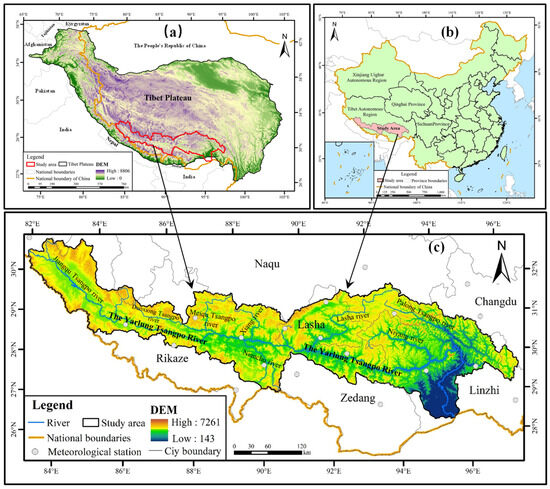
Figure 1.
The location of the Yarlung Tsangpo River Basin (referred to as YTRB). (a) The location of the YTRB in the Tibetan Plateau. (b) The location of the YTRB in China. (c) The DEM of the YTRB.
The average elevation of the YTRB is above 4000 m. The topography shows a distribution characterized by a high west and low east, high north and south, and a low center, (Figure 1c) [38]. The influence of warm and humid air currents and elevation fluctuations in the Bay of Bengal has resulted in the unique climate and vegetation composition of the YTRB. The annual rainfall in the study area ranges from 300 to 550 mm, and the mean annual temperature is about 6 °C [39]. According to the World Soil Database constructed by the Food and Agriculture Organization of the United Nations (FAO) and the Applied Systems Research Institute (ASRI) in Vienna, the YTRB includes 11 soil types, of which alpine soils have the largest distribution, accounting for more than 70% of the total area of the basin [40].
In addition, the YTRB contains three landcover types: grassland, woodland, and cropland, with grassland as the dominant vegetation type, accounting for more than 67% of the area (Figure 2). The landcover type during 1980–2000 was dominated by high covered grassland, with an area share of about 43% (Figure 2a–c,f). During 2010–2020, the landcover type was dominated by medium covered and low covered grassland, with an area share of about 26% (Figure 2d–f). Landcover types vary from upstream to downstream, in different landscape zones, such as alpine meadows, montane grasslands, montane and valley scrub grasslands, and montane forests in the YTRB [41].
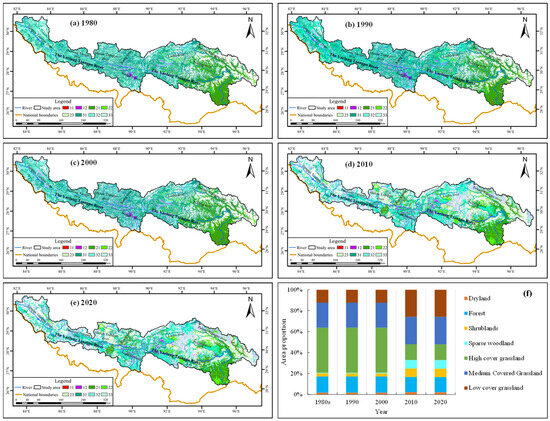
Figure 2.
Spatial distribution of the landcover in the YTRB. (a–e) Spatial distribution of the landcover over five periods (1980, 1990, 2000, 2010 and 2020). The type of landcover is indicated by a numeric code. Where 11 means paddy field, 12 means dry land, 21 means forest, 22 means shrubland, 23 means open woodland, 31 means high cover grassland, 32 means medium cover grassland and 33 means low cover grassland. (f) Area proportion of landcover type in each period.
2.2. Data Source
The data used in this paper consists of ATEM, PRE, and potential evapotranspiration data from meteorological observation stations, and NDVI remote sensing imagery data in the YTRB. The time series are all 1981–2020. The auxiliary research data include digital elevation (spatial resolution of 90 m), landuse data for five phases (1980, 1990, 2000, 2010 and 2020), river system, administrative division, and other basic geographic data of the YTRB.
Among them, the temperature, precipitation, and potential evapotranspiration data were derived from the China Meteorological Data Network (http://data.cma.cn/) (accessed on 1 January 2023). According to the continuity, temporal, and regional nature of meteorological data, the data from 21 meteorological stations, in and around the study area, were selected for the analysis in this study (Figure 1c). For NDVI remote sensing image data, GIMMS data, with a spatial resolution of 8 km × 8 km for 1981–1999, and MODIS data, with a spatial resolution of 1 km × 1 km, for 2000–2020 were used. The digital elevation, river system, administrative divisions and other basic geographic data of the YTRB were obtained from the National Center for Basic Geographic Information (http://www.gscloud.cn/) (accessed on 1 January 2023). The landuse data were obtained from the Resource and Environment Data Cloud Platform of the Chinese Academy of Sciences (http://www.resdc.cn/) (accessed on 1 January 2023).
2.3. Calculation Methods of Vegetation and Meteorological Indicators
2.3.1. Climate Variables and NDVI Data Preprocessing
Based on the ATEM, PRE, and potential evapotranspiration data from 21 meteorological stations, during 1981–2020 in the YTRB, the spatial distribution information of the long series of the three meteorological elements was obtained using the inverse distance weighted (IDW) spatial interpolation method of the ArcGIS 10.8 software [42]. The resolution of the NDVI remote sensing image data is relatively low and consistent, which makes it easy to analyze the dynamic changes in vegetation. Therefore, the resampling analysis tool of ArcGIS software was used to obtain NDVI image data, with a spatial resolution of 1 km × 1 km from 1981 to 2020.
2.3.2. Calculation of AET
In this study, the potential evapotranspiration was corrected to obtain the AET based on the actual growth of vegetation [43]. The calculation formula is as follows:
where is the AET. is the potential evapotranspiration. () is net surface radiation. () is soil heat flux. () is wet and dry table constants. is the water demand correction coefficient based on the effective precipitation of the vegetation, i.e., the effective precipitation is considered to be able to meet the water consumption of the natural forest. is the parameter corresponding to the different vegetation cover in each month. (mm) is the effective monthly rainfall.
2.3.3. Calculation of FVC
FVC is the vertical projection of vegetation in the air as a percentage of the total land area, and it is usually used to characterize the dynamics of vegetation cover on the surface [44,45]. It is usually estimated using NDVI, which is calculated as:
where is the element-by-element NDVI value. is the first pixel. is the minimum of the element-by-element NDVI value. is the maximum of the element-by-element NDVI value.
2.4. Analysis Methods of Trend Characteristics
2.4.1. Trend Analysis Methods
In this study, linear propensity estimation was used to analyze the temporal trends of ATEM, PRE, AET, and FVC [46]. With the help of ArcGIS software, the values of the elements in each image from the study area were separately regressed by one-way linear regression, and the slope obtained was used as the inter-annual change trend of each image. In turn, the spatial distribution of the trends of climate and vegetation elements in the YTRB was obtained. The calculation formula is:
where is the propensity to change in the time series of the raster variable on a grid-by-grid basis, which is a dimensionless value. When , it indicates an increasing trend. When , it indicates a decreasing trend. is the year. is the total number of years in the study time period, which was, for this study, 42 years. is the element value in year .
2.4.2. Single Correlation Analysis Methods
The correlation analysis of FVC with ATEM, PRE, and AET was performed separately on each image element in the study area [47]. The calculation formula is as follows:
where is the correlation coefficient of FVC with ATEM, PRE, and AET for each image of the YTRB. and are the values of FVC and climate factors for the image in year . and are the mean values of FVC and climate elements for the image element for years, respectively.
The significance of the obtained correlation coefficients was assessed using the test [48]. The formula is as follows:
where is single correlation coefficient. is the degree of freedom.
2.4.3. Partial Correlation Analysis Methods
A partial correlation coefficient was introduced to exclude the interference of other factors when studying the effect of the climate factor on FVC [49].
(1) The first order partial correlation coefficient.
The partial correlation coefficient for any two of the three variables is calculated by excluding the interference of the remaining one. It is called the first order partial correlation coefficient. The formula is as follows:
is the partial correlation coefficient between FVC and ATEM after excluding the PRE interference. , , and are simple correlation coefficients between FVC and ATEM, FVC and PRE, and ATEM and PRE, in that order.
(2) The second order partial correlation coefficient.
The partial correlation coefficient for any two of the four variables is calculated excluding the interference of the other two variables. It is called the second order partial correlation coefficient. The formula is as follows:
is the second order partial correlation coefficient between FVC and ATEM, after excluding the interference from PRE and AET. , , and represent the first order partial correlation coefficients between FVC and ATEM, FVC and AET, and ATEM and AET, in that order, after excluding the interference of PRE.
The significance of the obtained partial correlation coefficients was tested using test. The formula is as follows:
is partial correlation coefficient. is the degree of freedom.
2.4.4. Complex Correlation Analysis Methods
The complex correlation coefficient was introduced to study the combined correlation of FVC with ATEM, PRE and AET [50]. The formula is calculated as follows:
where is the estimated value of the FVC. is the complex correlation coefficient of thr FVC with ATEM, PRE, and AET. is the value of the FVC in the year. is the average value of FVC for consecutive years.
The significance of the obtained coefficients was tested using the test of significance [48]. The formula is as follows:
is the complex correlation coefficient. is the number of independent variables. is the degree of freedom.
3. Results
3.1. Characteristics of Vegetation Dynamics in the YTRB
The multi-year mean value of FVC was 0.31 during 1981–2020 in the YTRB, which showed a significant upward trend (p < 0.1) at a rate of 0.05/10a (Figure 3a). Spatially, the multi-year mean value of FVC in the YTRB was characterized as high in the east, low in the west, high in the south, and low in the north. The highest value was 0.94 in the downstream Linzhi area, and the lowest value was only 0.06 in the headwaters area. The proportion of FVC smaller than 0.5 in the whole basin area was 89.1% (Figure 3b). The rate of the annual mean FVC was −0.023/10a~0.26/10a during 1981–2020. The area with a significant increasing trend (p < 0.05) in the annual mean FVC accounted for up to 90% of the area. Significantly decreasing areas (p < 0.05) with patchy distribution existed only in the downstream Lasha and Linzhi territories (Figure 3c).
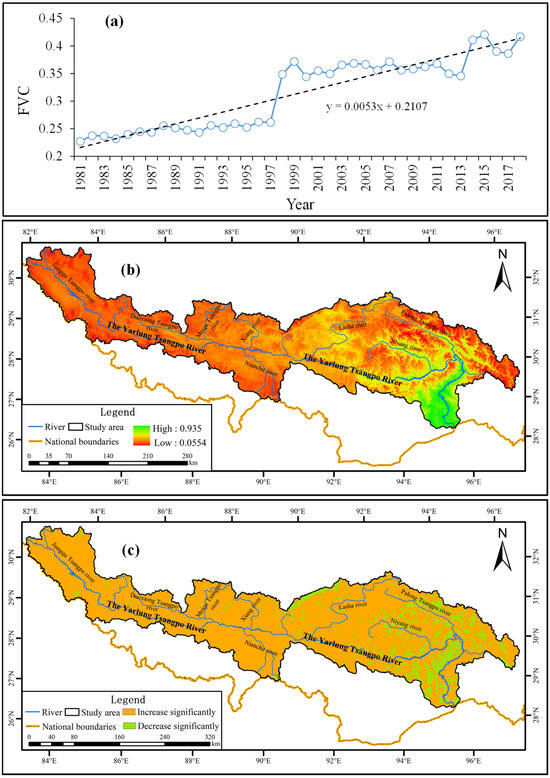
Figure 3.
Characteristics of temporal and spatial changes in fractional vegetation cover (referred to as FVC) of the YTRB during 1981–2020. (a) The time characteristics; (b) the spatial distribution characteristics; (c) the spatial distribution characteristics of the change rate.
3.2. Characteristics of Climate Variables in the YTRB
3.2.1. ATEM
The multi-year mean value of ATEM was 5.3 °C from 1981 to 2020 in the YTRB, with a significantly increasing trend (p < 0.05) at a rate of 0.38 °C/10a (Figure 4a). Spatially, the annual mean ATEM of the YTRB was characterized by high in the east, low in the west, low in the south, and high in the north (Figure 4b). The area of the higher annual mean ATEM was in the downstream area of Linzhi and eastern Rikaze, with a maximum ATEM of 1.2 °C. The annual mean ATEM was lower, at −0.02 °C in the area around Lhasa city. Annual mean ATEM increase rates in the study area ranged from 0.1 °C/10a to 0.7 °C/10a. The area with a significant increasing trend (p < 0.05) in the annual mean ATEM accounted for up to 98.4% of the total area of the study area (Figure 4c).

Figure 4.
Characteristics of the temporal and spatial changes in air temperature (referred to as ATEM) of the YTRB during 1981–2020. (a) The time characteristics; (b) the spatial distribution characteristics; (c) the spatial distribution characteristics of the change rate.
3.2.2. PRE
The multi-year mean value of PRE was 497.9 mm during 1981–2020 in the YTRB. The annual mean PRE showed an overall fluctuating upward trend, with a growth rate of 13.3 mm/10a (p < 0.05) (Figure 5a). Spatially, the annual mean PRE in the study area was higher in the upstream and downstream areas and lower in the middle reaches. Especially the downstream Linzhi area has a high PRE, which could reach 801.1 mm. In contrast, the PRE was smaller in Lhasa and Shigatse, with a difference of 485 mm from Linzhi. The annual mean PRE changed at a rate of −101.7 mm/10a to 60.2 mm/10a in the basin (Figure 5b). The region of the increasing annual mean PRE was larger than the decreasing region in the whole basin. The increasing trend was significant (p < 0.05), taking up 50% of the area in the central region. The decreasing trend was also significant (p < 0.05), presenting in 36% of the area within the downstream Linzhi (Figure 5c).
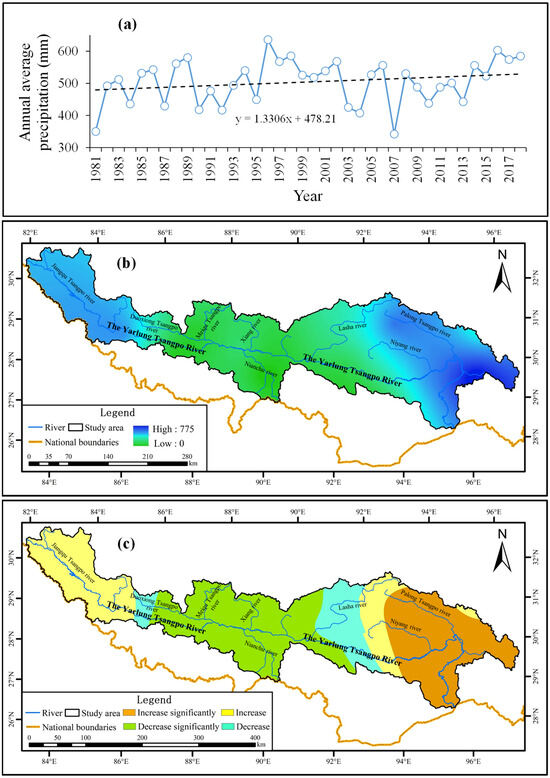
Figure 5.
Characteristics of temporal and spatial changes in precipitation (referred to as PRE) of the YTRB during 1981–2020. (a) The time characteristics; (b) the spatial distribution characteristics; (c) the spatial distribution characteristics of the change rate.
3.2.3. AET
The multi-year mean value of AET was 410.2 mm during 1981–2020 in the YTRB, and showed a significant upward trend (p < 0.05) at a rate of 32.8 mm/10a (Figure 6a). Spatially, the annual mean AET of the YTRB was high in the east and low in the west, high in the south and low in the north, especially in the downstream area of Linzhi, where the highest AET could reach 1586.69 mm. Mean annual AET ranged from 650 to 670 mm in 83.6% of the whole basin (Figure 6b). The annual mean AET change rates in the basin ranged from −110.7 mm/10a to 0 mm/10a. The areas showing a significant decreasing trend (p < 0.05) accounted for 98% of the whole basin. The decreasing trend was slower only in the downstream area of Linzhi (Figure 6c).
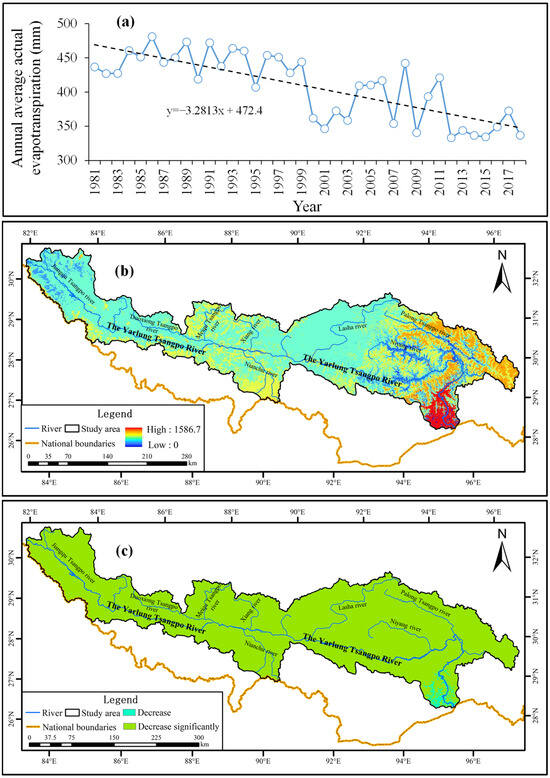
Figure 6.
Characteristics of temporal and spatial changes in actual evapotranspiration (referred to as AET) of the YTRB during 1981–2020. (a) The time characteristics; (b) the spatial distribution characteristics; (c) the spatial distribution characteristics of the change rate.
3.3. Correlation Analysis Between Vegetation Dynamics and Climatic Variables in the YTRB
3.3.1. Regression Analysis
The study showed that the FVC was positively correlated with ATEM and negatively correlated with PRE and AET in the YTRB from 1981 to 2020 (Figure 7). The degree of correlation was relatively good with ATEM and poor with PRE and AET. The phenomenon may be due to correlation differences between different regions within the basin. Therefore, the complex inter-annual trend of FVC was related to the changes in ATEM, PRE and ATEM in the YTRB, and a further spatial correlation analysis was still needed.
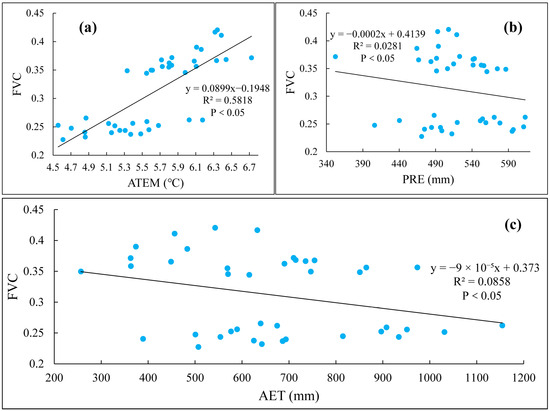
Figure 7.
Scatterplot of FVC in relation to ATEM, PRE and AET in the YTRB during 1981–2020. (a) The relation between FVC and ATEM; (b) the relation between FVC and PRE; (c) the relation between FVC and AET.
3.3.2. Single Correlation Analysis
The surface mean values of the single correlation coefficients of FVC with ATEM and PRE were 0.47 and 0.04 in the YTRB, which indicated that the positive correlation of FVC with ATEM was higher than that with PRE. However, the surface mean of the single correlation coefficient between FVC and AET was −0.21, indicating that the increase in AET had a negative effect on the increase in FVC in the study area. FVC was significantly positively correlated (p < 0.05) with the ATEM in 81.75% of the whole basin, and only 4.12% of the area in the downstream Linzhi City was significantly negatively correlated (p < 0.05) (Figure 8a). FVC was significantly positively correlated with PRE in 34.94% of the area in the middle section of the mainstem (p < 0.05). A significantly negative correlation was found in 18.78% of the whole basin, which was concentrated in the downstream watersheds of Niyang river and Palong Tsangpo river in Linzhi City (Figure 8b). FVC was significantly negatively correlated with AET in 24.96% of the area in the upstream section of the main stream (p < 0.05) (Figure 8c).
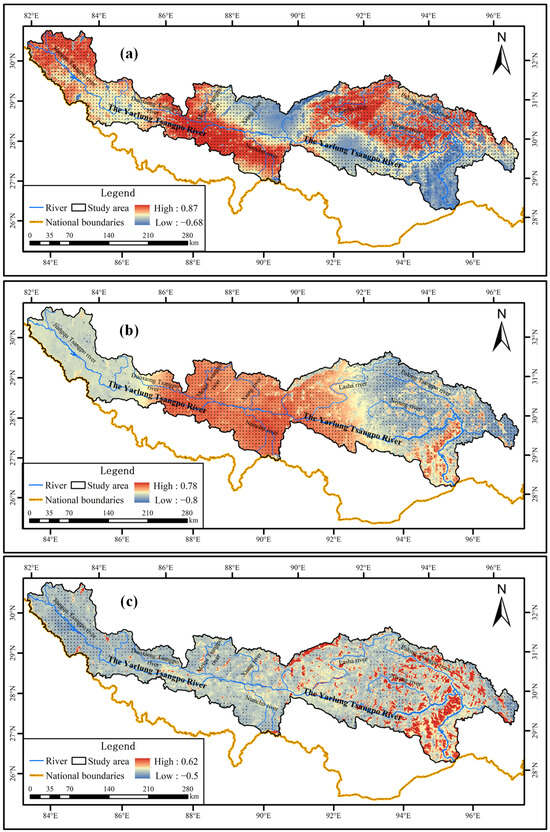
Figure 8.
Spatial distribution of the single correlation coefficients of FVC with ATEM, PRE, and AET in the YTRB during 1981–2020 (the black dotted area in the figure indicated that the 95% t-test was passed). (a) Single correlation coefficients between FVC and ATEM; (b) single correlation coefficients between FVC and PRE; (c) single correlation coefficients between FVC and AET.
3.3.3. Partial Correlation Analysis
The effects on FVC in the YTRB were further analyzed after excluding the other two climate elements from ATEM, PRE, and AET in turn. The surface mean of the partial correlation coefficient between ATEM and FVC was 0.44. Compared with the single correlation analysis, the positive correlation coefficient decreased by 6.38%. The spatial distribution of the areas significantly correlated between FVC and ATEM remained the same, but the area proportion decreased by 9.13% (Figure 9a). The surface mean of the partial correlation coefficient between PRE and FVC was 0.1. The degree of positive correlation was 2.5 times higher than that of the single correlation analysis. However, the area proportion of the areas where FVC was significantly correlated with PRE decreased by 13.32%, concentrating in the Niyang river basin and Palong Tsangpo river basin in the downstream Linzhi (Figure 9b). The surface mean of the partial correlation coefficient between AET and FVC was −0.27. The degree of negative correlation increased by 28.57% compared to the single correlation analysis. The area of the significant correlation between the FVC and AET moved from the upstream area to the middle and downstream areas, and the area share of the significantly negatively correlated areas increased by 33.48% (Figure 9c).
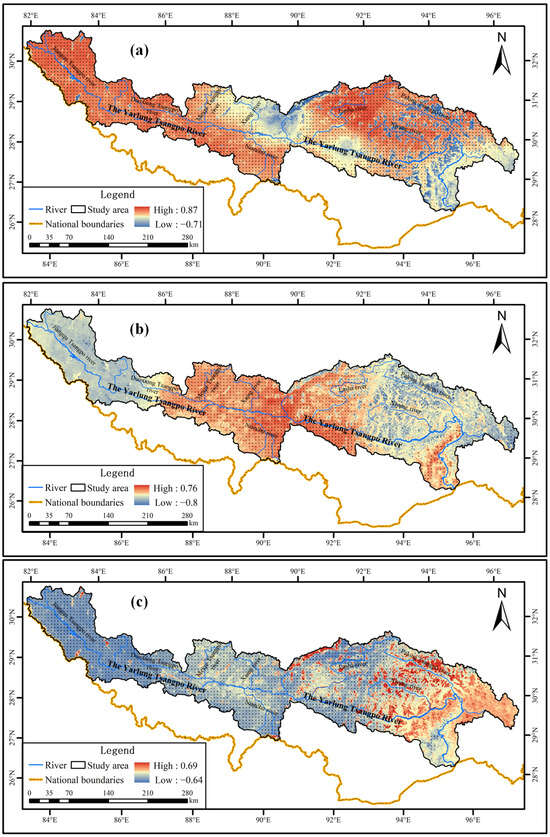
Figure 9.
Spatial distribution of the partial correlation coefficients of FVC with ATEM, PRE, and AET in the YTRB during 1981–2020 (the black dotted area in the figure indicated that the 95% t-test was passed). (a) Partial correlation coefficients between FVC and ATEM; (b) partial correlation coefficients between FVC and PRE; (c) partial correlation coefficients between FVC and AET.
3.3.4. Complex Correlation Analysis
Multiple regression analysis was performed using ATEM, PRE and AET data from 1981 to 2020 to obtain the time-series fitted values of FVC in the YTRB. The results showed that the decidability coefficient of the fitted values of FVC and FVC during the study period was 0.64, which passed the 95% significance test and resulted in a good fit (Figure 10). A comprehensive analysis found that the mean value of the complex correlation coefficients between FVC and ATEM, PRE, and AET was 0.3, and the overall performance of positive correlation (Figure 11). FVC was significantly positively correlated with the three factors in 47.43% of the whole basin, which was concentrated in the upstream Jiangqu Tsangpo river basin, Duoxiong Tsangpo river basin and Nianchu river basins. The area of the significant negative correlation between FVC and the three factors accounted for only 1.38% of the whole basin. It was distributed in the downstream Linzhi city.
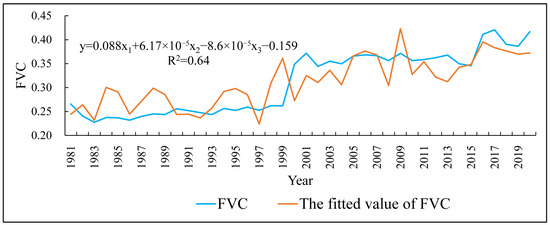
Figure 10.
Changes in the annual mean FVC in the YTRB during 1981–2020 (y: FVC; x1: ATEM; x2: PRE; x3: AET in the figure).
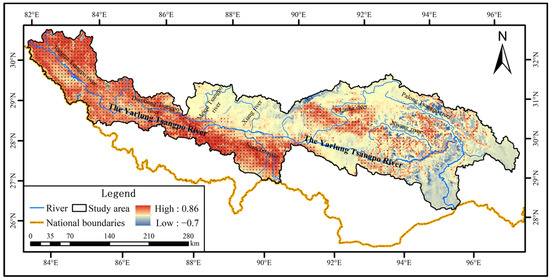
Figure 11.
Spatial distribution of the complex correlation coefficients of FVC with ATEM, PRE, and AET in the YTRB during 1981–2020 (the black dotted area in the figure indicated that the 95% t-test was passed).
4. Discussion
4.1. Characterization of Changes Vegetation Dynamics in the YTRB
In this study, we found a general increasing trend of FVC in the YTRB from 1981 to 2020, and these results were consistent with those from the previous studies in southwest China [51]. The difference was that the FVC existed in the area of significant reduction in a patchy distribution in the downstream Lasha and Linzhi cities. The dynamic evolution of vegetation is the result of the interaction between natural factors and human activities [52,53]. Some studies have shown that the FVC increased with increasing altitude within a reasonable range [54,55]. The average altitude of the YTRB was above 4000 m, and the vegetation type was dominated by alpine grassland and meadow [56]. The climatic conditions in this region were more suitable for the growth of this type of vegetation, and the FVC increased significantly with increasing altitude. In addition, regarding the use of population density, ecological restoration, and urbanization to characterize human activities in the YTRB, some studies found that the population of the basin as a whole was low, with a population density of less than 4 people/km2 in all areas, except for the eastern part of Rikaze city, Lasha city and Shannan city [57]. Natural factors have relatively greater influence on vegetation growth. Meanwhile, this study also showed that the urbanized area of the YTRB was 99 km2 during 1980–2015, which was concentrated in the territory of downstream Lhasa City and Linzhi City [57]. Therefore, the development of urbanization was the main reason for the significant decrease in FVC in the downstream Lasha and Linzhi cities [58,59].
4.2. Characterization of Changes Climate Variables in the YTRB
This study showed that the ATEM increased significantly in 98% of the YTRB during 1981–2020, but the AET decreased significantly in more than 98% of the YTRB. Although PRE maintained a fluctuating upward trend during this period, it decreased significantly in the downstream city of Linzhi. It was found that both ATEM and PRE have increased in the YTRB since the 1980s [60]. In particular, the annual mean ATEM on the Tibetan Plateau increased by 0.35 °C/10a during 1961–2020, which was more than twice the global warming rate during the same period, and it was the fastest warming rate in China [61,62]. The complex and unique topographic features were the key factors influencing the variation in PRE [63,64]. The topographic features of the YTRB, low in the east and high in the west, as well as the diverse geomorphological features, enabled the Indian Ocean warm and humid airflow to cool and condense easily during its ascent [65]. Meanwhile, the Yarlung Tsangpo River valley has cut through mountain ranges to the north and south, which provided a channel for water vapor transport [66,67]. However, some studies have also found that the reduced evaporative contribution of water vapor source from the ocean may lead to a reduction in PRE in the downstream Linzhi area [68]. For example, Xu and Gao (2019) pointed out that the decrease in precipitation in the southeastern Tibetan Plateau was due to the reduced evaporation from oceanic water vapor sources [69]. Li also reflected that the South Asian summer winds showed a weakening trend from 1949 to 2020, which would severely constrain the water vapor transport process on the southern side of the plateau [70]. The decrease in the AET in the YTRB had two causes. On the one hand, the average annual ATEM of the YTRB was only 5.3 °C, and the relatively weak evapotranspiration due to the low ATEM was one of the reasons for the large-scale reduction in the AET in the region [71]. On the other hand, glacial tundra was the typical landform type in the YTRB, and processes such as glacier retreat and permafrost melting released a large amount of water resources. However, these water resources might flow out of the basin, more in the form of runoff rather than returning to the atmosphere through evapotranspiration [72,73].
4.3. Response Analysis of Vegetation Dynamics to Climate Change in the YTRB
In this study, when analyzing the single correlation between FVC and ATEM, PRE, and AET, it was found that the increase in ATEM and the decrease in AET had a beneficial effect on the increase in FVC in the study area. The reasons for this include two main aspects. First, within the appropriate temperature range, the elevated ATEM can not only promote plant photosynthesis, but can also enhance the growth rate and biomass of vegetation [74,75]. Secondly, the rising temperatures on the Tibetan Plateau in the recent decades caused a rise in soil water content due to the melting of the cryosphere, which promotes rapid changes in vegetation growth dynamics [76]. In addition, the reduction in AET meant less water loss in soil and vegetation, which helped maintain the soil moisture and water supply to vegetation [77]. With limited water availability, the reduction in AET had a positive effect on vegetation growth and the increase in FVC [78].
After the three factors were sequentially excluded from the effects of the other two factors, there was a small decrease in the degree of influence of ATEM on FVC. The degree of influence of PRE on FVC was 2.5 times higher. The degree of influence of AET on FVC increased by 28.57%. Most of the studies showed that the role of ATEM in influencing the vegetation in the YTRB was mainly dominant [33]. Therefore, the variation in the effects of the ATEM on vegetation was small after excluding other factors. PRE was the main source of water needed for vegetation growth, which was directly related to the growth condition of vegetation [79,80]. Especially in the arid zone of Southwest China, the growth and development of vegetation showed high sensitivity to PRE [81,82]. AET mitigated the threat of drought to vegetation by reducing surface temperature and increasing atmospheric humidity [83]. The sensitivity of vegetation to PRE and AET was highlighted in this study after excluding the effect of ATEM, the dominant factor. However, the warming and humidifying trend in the YTRB had both promoting and inhibiting effects on vegetation, and showed some regional differences [24]. For example, the woodland consisted mostly of the territory of the downstream Linzhi city, which had PRE between 500 and 700 mm, and was compared to the overall levels in other regions. The increase in PRE had an inhibiting effect on the FVC in this area. The middle reaches are dominated by low vegetation such as grasslands, meadows, and shrubs. These vegetation types were more efficient in utilizing PRE [57]. Therefore, the decrease in the AET in this region promoted the efficient use of moisture by the regional vegetation, which in turn had a contributing effect on FVC.
After comprehensively analyzing the effects of ATEM, PRE, and AET on FVC, it was found that 47.43% of the area in the upper and middle reaches of the Yarlung Tsangpo River was positively affected. The moderate ATEM, adequate PRE, and relatively large AET in the upper and middle reaches of the Yarlung Tsangpo River section allowed the surface water to be fully utilized and recycled, which was conducive to maintaining vegetation growth and ecosystem stability [84]. In addition, these regions had relatively fewer human activities and less disturbance to the vegetation, which enabled the vegetation to maintain a high level of coverage and biodiversity [60]. It is noteworthy that the YTRB in the alpine zone is not only an important area for global biodiversity and ecological landscape conservation, but its vegetation cover and growth are also highly sensitive and indicative of global climate change. Over the last four decades, changes in the climatic factors have contributed to positive changes in vegetation dynamics in the region, which in turn have contributed to positive global climate change and carbon cycling. The study provides important data and cases for global climate change research, and it further promotes the development of climate change science and the development of strategies to address climate change.
5. Conclusions
In this study, we analyzed the spatial and temporal dynamics of vegetation cover and climate in the YTRB based on NDVI remote sensing image data, PRE, ATEM, and AET data during 1981–2020. The spatial and temporal response of the vegetation dynamics to climate change in the YTRB from 1981 to 2020 was systematically explored using a variety of correlation analysis methods. The main conclusions are as follows:
(1) From 1981 to 2020, the FVC in the YTRB showed an overall significant upward trend, at a rate of 0.05/10a. It also showed the spatial distribution characteristics of high in the east and low in the west, high in the south and low in the north. However, the development of the urbanization process caused a significant reduction in the area of patchy distribution of FVC in the downstream Lasha and Linzhi cities.
(2) From 1981 to 2020, the ATEM and PRE in the YTRB showed an increasing trend, and the AET showed a significant decreasing trend at a rate of 32.8 mm/10a. ATEM increased significantly, while AET decreased significantly in 98% of the whole basin, and PRE decreased significantly in 36% of the downstream Linzhi territory.
(3) A correlation analysis of FVC with ATEM, PRE, and AET in the YTRB found that both ATEM elevation and AET reduction played a positive role in the increase in FVC in the study area, and that the area positively correlated with ATEM accounted for a larger part of the whole basin. Excluding the effects of the other two factors, the degree of PRE’s impact on the FVC expands to 2.5 times its original level, and the degree of AET’s impact increases by 28.57%. However, the ATEM has remained as the dominant factor influencing the FVC. After a comprehensive analysis, it was found that the areas with strong correlation rows between the FVC and climate factors accounted for 47.43% of the whole basin, concentrated in the upper and middle reaches of the Yarlung Tsangpo River.
On the basis of global climate change, the spatial and temporal changes in vegetation dynamics in the YTRB are influenced by many factors, and this paper mainly investigates the correlation between three climate factors (ATEM, PRE, AET) and FVC. In addition to these three factors, they are also affected by human activities and landuse, and the mechanisms of these factors on vegetation dynamics need to be further explored.
Author Contributions
Conceptualization, F.L. and T.Q.; methodology, F.L.; software, F.L. and L.Z.; validation, J.T., J.G. and X.S.; formal analysis, F.L.; investigation, W.G.; resources, L.Z., J.G. and W.G.; data curation, F.L.; writing—original draft preparation, F.L.; writing—review and editing, L.Z. and T.Q. All authors have read and agreed to the published version of the manuscript.
Funding
This research was funded by the project of Power China Huadong Engineering Corporation Limited, grant number KY2022-NGH-02-02.
Institutional Review Board Statement
Not applicable.
Informed Consent Statement
Not applicable.
Data Availability Statement
The data presented in this study are available upon request from the corresponding author. The data are not publicly available due to privacy.
Acknowledgments
All authors thank the anonymous reviewers and editors, whose comments notably contributed to the improvement of this manuscript.
Conflicts of Interest
Authors Fang Liu, Junlong Tang, Jing Guo, Leilei Zhang and Weijian Guo was employed by the company Power China Huadong Engineering Corporation Limited. The remaining authors declare that the research was conducted in the absence of any commercial or financial relationships that could be construed as a potential conflict of interest.
Abbreviations
The following abbreviations are used in this manuscript:
| YTRB | The Yarlung Tsangpo River Basin |
| FAC | Fractional vegetation cover |
| ATEM | Air temperature |
| PRE | Precipitation |
| AET | Actual evapotranspiration |
References
- Hoffmann, W.A.; Jackson, R.B. Vegetation–climate feedbacks in the conversion of tropical savanna to grassland. J. Clim. 2000, 13, 1593–1602. [Google Scholar] [CrossRef]
- Bonan, G.B.; Pollard, D.; Thompson, S.L. Effects of boreal forest vegetation on global climate. Nature 1992, 359, 716–718. [Google Scholar] [CrossRef]
- Feng, T.J.; Wei, W.; Chen, L.D.; Cerdà, A.; Yang, L.; Yu, Y. Combining land preparation and vegetation restoration for optimal soil eco-hydrological services in the Loess Plateau, China. Sci. Total Environ. 2019, 657, 535–547. [Google Scholar] [CrossRef] [PubMed]
- Liu, W.; Li, Z.; Zhu, J.; Xu, C.; Xu, X. Dominant factors controlling runoff coefficients in karst watersheds. J. Hydrol. 2020, 590, 125486. [Google Scholar] [CrossRef]
- Luo, Y.W.; Ma, N.; Zhang, Y.Q.; Zang, C.F.; Szilagyi, J.; Tian, J.; Wang, L.H.; Xu, Z.W.; Tang, Z.X.; Wei, H.S. Response of alpine vegetation function to climate change in the Tibetan Plateau: A perspective from solar-induced chlorophyll fluorescence. Sci. Total Environ. 2024, 952, 175845. [Google Scholar] [CrossRef] [PubMed]
- Xiao, J.Y.; Xie, B.G.; Zhou, K.C.; Liang, C.; Li, J.H.; Xie, J.; Zhang, X.M. Bidirectional dependency between vegetation and terrestrial water storage in China. J. Hydrol. 2023, 626, 130313. [Google Scholar] [CrossRef]
- Deng, Y.; Wang, S.; Bai, X.; Luo, G.; Wu, L.; Chen, F.; Wang, J.; Li, C.; Yang, Y.; Hu, Z.; et al. Vegetation greening intensified soil drying in some semi-arid and arid areas of the world. Agric. For. Meteorol. 2020, 292–293, 108103. [Google Scholar] [CrossRef]
- Zhang, Y.Q.; Li, C.C.; Chiew, F.H.S.; Post, D.A.; Zhang, X.Z.; Ma, N.; Tian, J.; Kong, D.D.; Lenug, L.R.; Yu, Q.; et al. Southern Hemisphere dominates recent decline in global water availability. Science 2023, 382, 579–584. [Google Scholar] [CrossRef]
- Mudereri, B.T.; Chitata, T.; Mukanga, C.; Mupfiga, E.T.; Gwatirisa, C.; Dube, T. Can biophysical parameters derived from Sentinel-2 space-borne sensor improve land cover characterisation in semi-arid regions? Geocarto Int. 2021, 36, 2204–2223. [Google Scholar] [CrossRef]
- Mehmood, K.; Anees, S.A.; Rehman, A.; Tariq, A.; Zubair, M.; Liu, Q.; Rabbi, F.; Khan, K.A.; Luo, M. Exploring spatiotemporal dynamics of NDVI and climate-driven responses in ecosystems: Insights for sustainable management and climate resilience. Ecol. Inform. 2024, 80, 102532. [Google Scholar] [CrossRef]
- Anees, S.A.; Mehmood, K.; Rehman, A.; Rehman, N.U.; Muhammad, S.; Shahzad, F.; Hussain, K.; Luo, M.; Alarfaj, A.A.; Alharbi, S.A.; et al. Unveiling fractional vegetation cover dynamics: A spatiotemporal analysis using MODIS NDVI and machine learning. Environ. Sustain. Ind. 2024, 24, 100485. [Google Scholar] [CrossRef]
- Pan, S.A.; Anees, S.A.; Yang, X.R.; Mehmood, K. The stoichiometric characteristics and the relationship with hydraulic and morphological traits of the Faxon fir in the subalpine coniferous forest of Southwest China. Ecol. Indic. 2024, 159, 111636. [Google Scholar] [CrossRef]
- Anees, S.A.; Zhang, X.; Shakeel, M.; Alkahtani, M.A.; Khan, K.A.; Akram, M.; Ghramh, H.A. Estimation of fractional vegetation cover dynamics based on satellite remote sensing in Pakistan: A comprehensive study on the FVC and its drivers. J. King Saud Univ. Sci. 2022, 34, 101848. [Google Scholar] [CrossRef]
- Pal, S.; Ziaul, S.K. Detection of land use and land cover change and land surface temperature in English Bazar urban centre. Egypt. J. Remote Sens. 2017, 20, 125–145. [Google Scholar] [CrossRef]
- Mu, X.H.; Yang, Y.; Xu, H.; Guo, Y.H.; Lai, Y.K.; Mcvicar, T.R.; Xie, D.H.; Yan, G.J. Improvement of NDVI mixture model for fractional vegetation cover estimation with consideration of shaded vegetation and soil components. Remote Sens. Environ. 2024, 314, 114409. [Google Scholar] [CrossRef]
- Wu, Y.Y.; Fang, H.W.; He, G.J.; Huang, L.; Wang, J.Y. Climate-driven changes in hydrological and hydrodynamic responses in the Yarlung Tsangpo River. J. Hydrol. 2021, 598, 126267. [Google Scholar] [CrossRef]
- Adeyeri, O.E.; Zhou, W.; Ndehedehe, C.E.; Wang, X. Global vegetation, moisture, thermal and climate interactions intensify compound extreme events. Sci. Total Environ. 2024, 912, 169261. [Google Scholar] [CrossRef]
- Adeyeri, O.E.; Luax, P.; Ishola, K.A.; Zhou, W.; Balogun, I.A.; Adeyewa, Z.D.; Kunstmann, H. Homogenising meteorological variables: Impact on trends and associated climate indices. J. Hydrol. 2022, 607, 127585. [Google Scholar] [CrossRef]
- Adeyeri, O.E.; Zhou, W.; Wang, X.; Zhang, R.H.; Laux, P.; Ishola, K.A.; Usman, M. The trend and spatial spread of multisectoral climate extremes in CMIP6 models. Sci Rep. 2022, 12, 21000. [Google Scholar] [CrossRef] [PubMed]
- Xue, Y.X.; Lu, H.W.; Guan, Y.L.; Tian, P.P.; Yao, T.C. Impact of thermal condition on vegetation feedback under greening trend of China. Sci. Total. Environ. 2021, 785, 147380. [Google Scholar] [CrossRef] [PubMed]
- Liu, Y.C.; Li, Z.; Chen, Y.N.; Kayumba, P.M.; Wang, X.X.; Liu, C.X.; Long, Y.X.; Sun, F. Biophysical impacts of vegetation dynamics largely contribute to climate mitigation in High Mountain Asia. Agr. Forest. Meteorol. 2022, 327, 109233. [Google Scholar] [CrossRef]
- Immerzeel, W.W.; Lutz, A.F.; Andrade, M.; Bahl, A.; Biemans, H.; Bolch, T.; Hyde, S.; Brumby, S.; Davies, B.J.; Elmore, A.C.; et al. Importance and vulnerability of the world’s water towers. Nature 2020, 577, 364–369. [Google Scholar] [CrossRef] [PubMed]
- Liu, L.; Niu, Q.K.; Heng, J.X.; Li, H.; Xu, Z.X. Characteristics of dry and wet conversion and dynamic vegetation response in Yarlung Zangbo River basin. Trans. Chin. Soc. Agric. Eng. 2023, 36, 175–184. [Google Scholar] [CrossRef]
- Huang, Q.; Zhang, Y.Q.; Li, C.C.; Ma, N. Quantifying propagation effects of climate and vegetation changes on evapotranspiration and streamflow signatures in Yarlung Tsangpo River Basin. J. Hydrol. Reg. Stud. 2024, 56, 102015. [Google Scholar] [CrossRef]
- Pang, G.J.; Wang, X.J.; Yang, M.X. Using the NDVI to identify variations in, and responses of, vegetation to climate change on the Tibetan Plateau from 1982 to 2012. Quatern. Int. 2017, 444, 87–96. [Google Scholar] [CrossRef]
- Shao, Q.; Cao, W.; Fan, J.; Huang, L.; Xu, X. Effects of an ecological conservation and restoration project in the Three-River Source Region, China. J. Grogr. Sci. 2017, 27, 183–204. [Google Scholar] [CrossRef]
- Meng, Q.B.; Liu, Y.L.; Ju, Q.; Liu, Y.; Wang, G.Q.; Jin, J.L.; Guan, T.S.; Liu, C.S.; Bao, Z.X. Vegetation change and its response to climate change in the Yarlung Zangbo River basin in the past 18 years. SNWTT 2021, 19, 539–550. [Google Scholar] [CrossRef]
- Jiang, L.; Feng, W.L.; Guo, B. Analysis of dynamic monitoring of vegetation change and the correlation with precipitation factor in Yalu Tsangpo River Basin during the past 13 years. Res. Environ. Yangtze Basin 2014, 23, 1610–1619. [Google Scholar]
- Guo, B.; Jiang, L.; Ge, D.Z.; Shang, M. Driving mechanism of vegetation coverage change in the Yarlung Zangbo River Basin under the stress of global warming. J. Trop. Subtrop. Bot. 2017, 25, 209–217. [Google Scholar]
- Lv, Y.; Dong, G.T.; Yang, S.T.; Zhou, Q.W.; Cai, M.Y. Spatio-temporal variation in NDVI in the Yarlung Zangbo River Basin and its relationship with precipitation and elevation. Resour. Sci. 2014, 36, 603–611. [Google Scholar]
- Han, X.M.; Zuo, D.P.; Li, P.J.; Xu, Z.X.; Gao, X.X. Spatiotemporal variability of vegetation cover and its response to climate change in Yarlung Zangbo River Basin. Adv. Sci. Technol. Water Resour. 2021, 41, 16–23. [Google Scholar] [CrossRef]
- Li, H.; Li, Y.K.; Shen, W.; Li, Y.A.; Lin, J.; Lu, X.; Xu, X.; Jiang, J. Elevation-dependent vegetation greening of the Yarlung Zangbo River Basin in the Southern Tibetan Plateau, 1999–2013. Remote Sens. 2015, 7, 16672–16687. [Google Scholar] [CrossRef]
- Cui, L.; Pang, B.; Zhao, G.; Ban, C.; Ren, M.; Peng, D.; Zuo, D.; Zhu, Z. Assessing the sensitivity of vegetation cover to climate change in the Yarlung Zangbo River Basin using machine learning algorithms. Remote Sens. 2022, 14, 1556. [Google Scholar] [CrossRef]
- Li, H.D.; Jiang, J.; Chen, B.; Li, Y.K.; Xu, Y.Y.; Shen, W.S. Pattern of NDVI-based vegetation greening along an altitudinal gradient in the eastern Himalayas and its response to global warming. Environ. Monit. Assess. 2016, 188, 186. [Google Scholar] [CrossRef]
- Zhu, Y.X.; Zheng, Z.T.; Zhao, G.; Zhu, J.T.; Zhao, B.; Sun, Y.H.; Gao, J.; Zhang, Y.J. Evapotranspiration increase is more sensitive to vegetation greening than to vegetation type conversion in arid and semi-arid regions of China. GPC 2025, 244, 104634. [Google Scholar] [CrossRef]
- Berholtz, N.; Lukyanov, V.; Cohen, S.; Zipilevitz, E.; Gilad, Z.; Silverman, D.; Adler, U.; Tanny, J. Irrigation of protected pepper crops according to growth stage using dynamic evapotranspiration estimates increases the water use efficiency. Sci. Hortic. 2023, 310, 111768. [Google Scholar] [CrossRef]
- Zhang, Y.L.; Liu, L.S.; Li, B.Y.; Zheng, D. Comparison of boundary datasets covering Tibetan Plateau between 2021 and 2014 versions. J. Glob. Change Data Discov. 2021, 5, 32–42. [Google Scholar] [CrossRef]
- Linke, S.; Lehner, B.; Ouellet, D.C.; Ariwi, J.; Grill, G.; Anand, M.; Beames, P.; Burchard, L.V.; Maxwell, S.; Moidu, H.; et al. Global hydro-environmental sub-basin and river reach characteristics at high spatial resolution. Sci. Data 2019, 6, 283. [Google Scholar] [CrossRef] [PubMed]
- Shi, X.; Zhang, F.; Lu, X.; Wang, Z.; Gong, T.; Wang, G.; Zhang, H. Spatiotemporal variations of suspended sediment transport in the upstream and midstream of the Yarlung Tsangpo River (the upper Brahmaputra), China. Earth. Surf. Proc. Land. 2018, 43, 432–443. [Google Scholar] [CrossRef]
- Liu, J.P. Study of the Climate Change and Underlying Surface Change as well as Their Runoff Effects in the Yarlung Zangbo River Basin. Ph.D. Dissertation, University of Chinese Academy of Sciences, Beijing, China, 2019. [Google Scholar]
- Wei, D.; Zhao, H.; Zhang, J.X.; Qi, Y.H.; Wang, X.D. Human activities alter response of alpine grasslands on Tibetan Plateau to climate change. J. Environ. Manag. 2020, 262, 110335. [Google Scholar] [CrossRef]
- Mini, M.A.; Torkan, G.; Eslamian, S.; Zareian, M.J.; Adamowski, J.F. Analysis of deterministic and geostatistical interpolation techniques for mapping meteorological variables at large watershed scales. Acta. Geophys. 2019, 67, 275. [Google Scholar] [CrossRef]
- Jiang, T.L.; Su, X.L.; Guo, S.M.; Wu, H.J. Spatiotemporal variation of vegetation water consumption and its response to meteorological drought in Northwest China. J. Health Econ. 2021, 52, 229–240. [Google Scholar] [CrossRef]
- Cheng, D.Y.; Li, X.D. Vegetation coverage change in a karst area and effects of terrain and population. J. Geo-Inf. Sci. 2019, 21, 1227–1239. [Google Scholar] [CrossRef]
- Yang, J.; Jia, L.; Hao, J.; Luo, Q.; Chi, W.; Wang, Y.; Zheng, H.; Yuan, R.; Na, Y. Temporal and Spatial Variation Characteristics of the Ecosystem in the Inner Mongolia Section of the Yellow River Basin. Atmosphere 2024, 15, 827. [Google Scholar] [CrossRef]
- Wang, T.; Fan, G.; Zhang, H.; Shen, X. Temporal and Spatial Variability of Ground Frost Indices in Northeast China. Atmosphere 2024, 15, 817. [Google Scholar] [CrossRef]
- Hou, J.; Du, L.; Liu, K.; Hu, Y.; Zhu, Y. Characteristics of vegetation activity and its responses to climate change in desert/grassland biome transition zones in the last 30 years based on GIMMS3g. Theor. Appl. Climatol. 2019, 136, 915–928. [Google Scholar] [CrossRef]
- Li, Z.; Jiang, F.Q. A study of abrupt climate change in Xinjiang Region during 1961–2004. J. Glaciol. Geocryol. 2007, 3, 351–359. [Google Scholar] [CrossRef]
- Feng, Y.; Su, H.; Tang, Z.; Wang, S.; Zhao, X.; Zhang, H.; Ji, C.; Zhu, J.; Xie, P.; Fang, J. Reduced resilience of terrestrial ecosystems locally is not reflected on a global scale. Commun. Earth. Environ. 2021, 2, 88. [Google Scholar] [CrossRef]
- Wang, J.C.; Guo, J.X.; Xu, J.; Li, F. Multi-time scales change Characteristics and Relationship of Meteorological Variables in the Upper and Middle Regions of the Huaihe River Basin in Recent 55 Years. Acta Geogr. Sin. 2017, 37, 611–619. [Google Scholar] [CrossRef]
- Wu, L.; Zhou, J.; Li, H.C.; Luo, W.Q. Analysis on the response of land use/land cover and ecological service value to topographic changes in the mountainous areas of Southwest China. Pol. J. Environ. Stud. 2024, 33, 6423–6442. [Google Scholar] [CrossRef]
- Li, X.; Yang, D.; Feng, L.; Huang, Y.; Yi, W. Dynamics of vegetation NDVI in Chengdu-Chongqing economic circle from 2000 to 2018. Chin. J. Ecol. 2021, 40, 2967–2977. [Google Scholar] [CrossRef]
- Zhu, L.; Sun, S.; Li, Y.; Liu, X.; Hu, K. Effects of climate change and anthropogenic activity on the vegetation greening in the Liaohe River basin of Northeastern China. Ecol. Ind. 2023, 148, 110105. [Google Scholar] [CrossRef]
- Rawaz, R.H.; Waso, O.L. NDVI forest cover changes at high altitudes of the Sulaymaniyah Governorate of Kurdistan Region, Northern Iraq, 1984–2021. Geogr. J. Geogr. Assoc. 2023, 108, 74–85. [Google Scholar] [CrossRef]
- Tao, S.; Kuang, T.; Peng, W.; Wang, G. Analyzing the spatio-temporal variation and drivers of NDVI in upper reaches of the Yangtze River from 2000 to 2015: A case study of Yibin city. Acta. Ecol. Sin. 2020, 40, 5029–5043. [Google Scholar]
- Zuo, D.P.; Han, Y.N.; Xu, Z.X.; Li, P.J.; Ban, W.C.S.; Pang, B.; Peng, D.Z.; Kan, G.Y.; Zhang, R.; Yang, H. Time-lag effects of climatic change and drought on vegetation dynamics in an alpine river basin of the Tibet Plateau, China. J. Hydrol. 2021, 600, 126532. [Google Scholar] [CrossRef]
- Wang, Z.Y.; Song, W.; Yin, L.C. Responses in ecosystem services to projected land cover changes on the Tibetan Plateau. Ecol. Indic. 2022, 142, 109228. [Google Scholar] [CrossRef]
- Aslam, M.S.; Huanxue, P.; Sohail, S.; Majeed, M.T.; Rahman, S.U.; Anees, S.A. Assessment of major food crops production-based environmental efficiency in China, India, and Pakistan. Environ. Sci. Pollut. 2022, 29, 10091–10100. [Google Scholar] [CrossRef]
- Mehmood, K.; Anees, S.A.; Rehman, A.; Rehman, N.U.; Muhammad, S.; Shahzad, F.; Liu, Q.; Alharbi, S.A.; Alfarraj, S.; Ansari, M.J.; et al. Assessment of climatic influences on net primary productivity along elevation gradients in temperate ecoregions. Trees For. People 2024, 18, 100657. [Google Scholar] [CrossRef]
- Wang, X.D.; Wang, R.J. Terrain Gradient Effect of Land Use and Its Driving Factors in the Qinghai-Tibet Plateau. Pol. J. Environ. Stud. 2022, 31, 5299–5312. [Google Scholar] [CrossRef]
- Li, Y.; Zhuang, J.; Bai, P.; Yu, W.; Zhao, L.; Huang, M.; Xing, Y. Evaluation of three long-term remotely sensed precipitation estimates for meteorological drought monitoring over China. Remote Sens. 2023, 15, 86. [Google Scholar] [CrossRef]
- Ministry of Ecology and Environment of the People’s Republic of China. Fourth National Communication on Climate Change of the People’s Republic of China, Part 3; Ministry of Ecology and Environment: Beijing, China, 2023; pp. 40–75.
- Nlend, B.; Huneau, F.; Garel, E.; Santoni, S.; Mattei, A. Precipitation isoscapes in areas with complex topography: Influence of large-scale atmospheric dynamics versus microclimatic phenomena. J. Hydrol. 2023, 617, 128896. [Google Scholar] [CrossRef]
- Li, G.P.; Yu, Z.B.; Wang, W.G.; Ju, Q.; Chen, X. Analysis of the spatial Distribution of precipitation and topography with GPM data in the Tibetan Plateau. Atmos. Res. 2021, 247, 105259. [Google Scholar] [CrossRef]
- Yang, H.; Cui, C.G.; Wang, X.F.; Zhang, W.G.; Wang, B. Research progresses of precipitation variation over the Yarlung Zangbo River basin under global climate warming. Torrential Rain Disasters 2019, 38, 565–575. [Google Scholar]
- Yang, K.; Wu, H.; Qin, J.; Lin, C.G.; Tang, W.J.; Chen, Y.Y. Recent climate changes over the Tibetan Plateau and their impacts on energy and water cycle: A review. Glob. Planet Change 2014, 112, 79–91. [Google Scholar] [CrossRef]
- Li, B.; Yang, L.; Tang, S.H. The climatic characteristics of summer convection over the Tibetan Plateau revealed by geos-tationary satellite. Acta Meteorol. Sin. 2018, 76, 983–995. [Google Scholar] [CrossRef]
- Zhang, C. Moisture source assessment and the varying characteristics for the Tibetan Plateau precipitation using TRMM. Environ. Res. Lett. 2020, 15, 104003. [Google Scholar] [CrossRef]
- Xu, Y.; Gao, Y.H. Quantification of evaporative sources of precipitation and its changes in the southeastern Tibetan Plateau and middle Yangtze River Basin. Atmosphere 2019, 10, 428. [Google Scholar] [CrossRef]
- Zhang, D.X.; Yan, H.; Miao, Y.; Zhang, M. Analysis of Water Vapor Transport Reduction in the Yarlung Tsangpo Grand Canyon Region: A Trajectory Tracking Approach. Plateau Meteorol. 2024, 43, 114–126. [Google Scholar] [CrossRef]
- Rahman, M.; Azim, S.; Jannat, F.; Rony, M.R.H.; Ahmad, B.; Sarkar, M.A.R. Quantification of rainfall, temperature, and reference evapotranspiration trend and their interrelationship in sub-climatic zones of Bangladesh. Heliyon 2023, 9, e19559. [Google Scholar] [CrossRef] [PubMed]
- Rasouli, K.; Pomeroy, J.W.; Whitfield, P.H. Are the effects of vegetation and soil changes as important as climate change impacts on hydrological processes? Hydrol. Earth. Syst. Sci. 2019, 23, 4933–4954. [Google Scholar] [CrossRef]
- Wang, T.H.; Yang, D.W.; Fang, B.J.; Yang, W.C.; Qin, Y.; Wang, Y.H. Data-driven mapping of the spatial distribution and potential changes of frozen ground over the Tibetan Plateau. Sci. Total. Environ. 2019, 649, 515–525. [Google Scholar] [CrossRef] [PubMed]
- Xie, J.L.; Yin, G.F.; Ma, D.J.; Chen, R.; Zhao, W.; Xie, Q.Y.; Wang, C.; Lin, S.R.; Yuan, W.P. Climatic limitations on grassland photosynthesis over the Tibetan Plateau shifted from temperature to water. Sci. Total. Environ. 2024, 906, 167663. [Google Scholar] [CrossRef]
- Liu, Y.W. Optimum temperature for photosynthesis: From leaf- to ecosystem-scale. Sci. Bull. 2020, 65, 601–604. [Google Scholar] [CrossRef] [PubMed]
- Suzuki, K.; Hiyama, T.; Matsuo, K.; Ichii, K.; Iijima, Y.; Yamazaki, D. Accelerated continental-scale snowmelt and ecohydrological impacts in the four largest Siberian river basins in response to spring warming. Hydrol. Process. 2020, 34, 3867–3881. [Google Scholar] [CrossRef]
- Wang, Y.S.; Zhang, Y.Z.; Yu, X.X.; Jia, G.D.; Liu, Z.Q.; Sun, L.B.; Zheng, P.F.; Zhu, X.H. Grassland soil moisture fluctuation and its relationship with evapotranspiration. Ecol. Indic. 2021, 131, 108196. [Google Scholar] [CrossRef]
- Lin, Z.; Long, T.; Jiao, W.; Ye, Z.; Zhang, D.; He, G. Estimation and spatiotemporal analysis of actual evapotranspiration over Qinghai-Tibet Plateau using an Alpine Grassland-Adapted Priestley-Taylor model. J. Hydrol. 2024, 641, 131756. [Google Scholar] [CrossRef]
- Wang, T.; Yang, M.H.; Yan, S.J.; Geng, G.P.; Li, Q.H.; Wang, F. Temporal and spatial vegetation index variability and response to temperature and precipitation in the Qinghai-Tibet Plateau using GIMMS NDVI. Pol. J. Environ. Stud. 2020, 29, 4385–4395. [Google Scholar] [CrossRef]
- Adhikari, S.; Zhou, W.; Dou, Z.; Sakib, N.; Ma, R.; Chaudhari, B.; Liu, B. Analysis of Flash Drought and Its Impact on Forest Normalized Difference Vegetation Index (NDVI) in Northeast China from 2000 to 2020. Atmosphere 2024, 15, 818. [Google Scholar] [CrossRef]
- Sun, H.; Wang, X.; Fan, D.; Sun, O. Contrasting vegetation response to climate change between two monsoon regions in southwest china: The roles of climate condition and vegetation height. Sci. Total. Environ. 2021, 802, 149643. [Google Scholar] [CrossRef] [PubMed]
- Peng, W.; Zhang, D.; Luo, Y.; Tao, S.; Xu, X. Influence of natural factors on vegetation NDVI using geographical detection in Sichuan province. Acta. Geogr. Sin. 2019, 74, 1758–1776. [Google Scholar] [CrossRef]
- Perez, M.; Lombardi, D.; Bardino, G.; Vitale, M. Drought assessment through actual evapotranspiration in Mediterranean vegetation dynamics. Ecol. Indic. 2024, 166, 112359. [Google Scholar] [CrossRef]
- Zhang, L.N.; Xu, E.Q. Effects of agricultural land use on soil nutrients and its variation along altitude gradients in the downstream of the Yarlung Zangbo River Basin, Tibetan Plateau. Sci. Total. Environ. 2023, 905, 167583. [Google Scholar] [CrossRef] [PubMed]
Disclaimer/Publisher’s Note: The statements, opinions and data contained in all publications are solely those of the individual author(s) and contributor(s) and not of MDPI and/or the editor(s). MDPI and/or the editor(s) disclaim responsibility for any injury to people or property resulting from any ideas, methods, instructions or products referred to in the content. |
© 2025 by the authors. Licensee MDPI, Basel, Switzerland. This article is an open access article distributed under the terms and conditions of the Creative Commons Attribution (CC BY) license (https://creativecommons.org/licenses/by/4.0/).